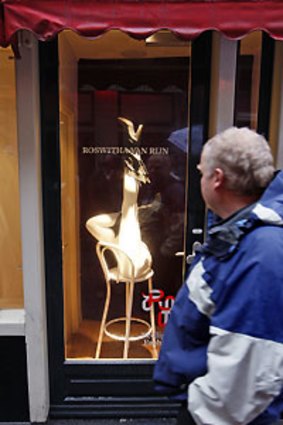
Windows in Amsterdam's red light now feature art, instead of prostitutes.Credit: Reuters
Red lights still glow in the small rooms along one of Amsterdam's inner city alleys, but the beds are gone and artists are working on creative installations where prostitutes used to entertain clients.
As part of efforts to revitalize its center and rein in a mushrooming red light district, the city of Amsterdam in cooperation with a housing corporation has acquired some former brothel rooms and rented them out to artists as studios.
Some customers, however, are yet to catch on to the changes.
"Is Patricia in here?" an old man asks in Spanish after knocking on the window of one newly converted art studio.
"They still don't realise the prostitutes are gone," Dutch artist Niels Vis said after the interruption.
To fight organized crime and clean up Amsterdam's center, authorities plan to halve the number of brothels and marijuana selling coffee shops, which have been a major pull for tourists to the city, and limit prostitution to certain areas.
Last week, the government said it planned further measures to fight forced prostitution and human trafficking such as a registration requirement for prostitutes and stricter permit rules for brothels, escort agencies and massage salons.
Only one prostitute window is left on the Korsjespoortsteeg alley. "It feels a bit like we pushed the prostitutes out," Vis said.
But while the prostitutes' union was less enthusiastic about a project in which designers displayed fashion gowns and handbags in former windows, a spokeswoman for the union said that prostitutes and artists are used to living side by side.
"Prostitutes and artists can live together, like they did in Paris in the 19th century," said Metje Blaak, spokeswoman for the Rode Draad union, although she added that she did not want to see artists taking over the district.
Prostitutes and their experiences have often inspired artists, including 19th century French painter Henri de Toulouse-Lautrec, who used Parisian prostitutes as models for his posters and paintings.
In the mid-1970s, Serbian artist Marina Abramovic exchanged roles with a prostitute in Amsterdam for a few hours and recorded both her experience and the experience of the prostitute for a photo exhibition.
The Red Artists-In-Residency (Red AIR) project provides Dutch and international artists with a space to work on projects exploring the role of art in areas undergoing urban transformation.
Individual projects include turning a former prostitute's room into a public library, displaying photos of modern architecture in the window of another, and creating posters and badges with provocative statements such as 'I Revolt'.
Red AIR plans a final exhibition in the second half of this year and is part of the city's Redlight concept -- a program aimed at diversifying the district, which has also included the fashion and a jewelry design project.
Reuters
Sign up for the Traveller Deals newsletter
Get exclusive travel deals delivered straight to your inbox. Sign up now.